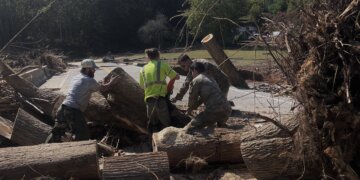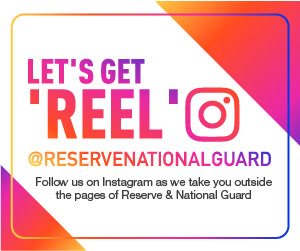Disaster preparation tends to be one of those conversations that we place on hold until we are reminded that we need it — like, when the weatherman announces a hurricane has formed off the Atlantic Coast or a wall cloud with a hook echo has formed nearby.
It is a dry subject, one much like talking budgets or OPSEC. Everso important to the health of our households, but low on the to-do list when life is happening every single day. For military personnel, it is a normal part of the job to go where the threat lies. That’s just what the uniform demands. And, in the cases where you are called upon to respond to the danger, you are often armed with a clear plan, proper equipment, and necessities for an extended period of time. That readiness does not always translate on the home front, however, and military families may often be caught in a reactive mode rather than a proactive state.
Captain Ronald “DJ” Desjardin, the Homeland Response Force Liaison Officer to Region 10’s HRF, says the number one error people make when it comes to emergency preparedness is failing to plan at all.
“The most common mistakes families make in preparing for disasters is simply not actually preparing — not making preparedness kits, not having a plan, not discussing this with their children, not planning for pets, not planning for any prescriptions they need to have or their private, personal documents in case of a disaster,” he said. “My biggest advice is to go to the website ready. gov — FEMA’s website — and there are fantastic examples of how easy it is to build and prepare a preparedness kit, to sit down and talk to your kids about where would you go if you’re displaced.”

Communicate expectations
Desjardin, who has served with the Alaska National Guard for five years, explains it is important that military personnel communicate to their family what their role may or may not be when an emergency event occurs. In some instances, Guardsmen may be activated as part of a response, and the family will need to lean on the emergency preparedness plan without them.
“Just as military members go toward a fight in a wartime scenario, they’re also called to go toward the disaster and support the state,” he said. “Our National Guardsmen are community members. We are citizens of our state, but we also understand we have an obligation to help Alaskans in times of a disaster so we prepare our families that we’re going to run towards that disaster and have to make sure that they’re safe and secure at home, and they know what the plan is.”
Technology as a tool
As part of prepping a household for a number situations, devising a list of go-to resources can help alleviate stress once an event does occur. Desjardin says emerging technology has made it easier to access the most up-to-date information.
“Ideally, families are always prepared, but if communications are down and they’re not as prepared as they should be the number one place they can go to seek help and information is social media,” he said. “Most disaster-related organizations, Facebook is their number one way to communicate a status of something.”

There’s an app for that
A survey conducted by the American Red Cross showed that 20% of Americans have used apps to get emergency information. The organization created six disaster apps, free to download, that alert users to different severe weather and emergency alerts. Plus, there is a kid-friendly version, called the Monster Guard, that uses characters to help children learn about emergency preparedness through interactive games.
Peter Macias, director of communications for American Red Cross’s Service to Armed Forces program, has worked for the organization for 13 years initially starting off in disaster work. In addition to the apps, the Red Cross offers information on how to build a kit and where to find shelters for safety. He says step one in getting started on your family’s disaster prep is getting everyone involved an informed.
“The basic steps for general preparedness are the same for most disasters — whether it’s a hurricane or a flood or a tornado or an earthquake,” he said. “… you want to get informed about what’s going on … you definitely want to include the entire family as you’re doing this.”
Military families move often, which means they may get orders to somewhere unfamiliar. The PCS checklist covers items such as finding a school and housing, but an important point that is omitted is becoming familiar with what to expect at that duty station. An earthquake or tornado is not going to wait for boxes to be unpacked before unexpectedly hitting an area. Macias suggests taking the following steps:
1. Be informed about what your area is prone to:
Conduct research on the Weather Channel, or contact your local Chamber of Commerce and Red Cross office. Family readiness point of contacts can also offer information on a unit’s procedures for sharing updates.
2. Develop a plan & discuss it with the entire family:
Planning should be a family affair, include everyone from kids all the way to any older adults in the details. Do not assume that family members will have enough time to figure it out once an emergency event occurs. Proactive planning is key.
3. Build a kit out of something easily transportable:
The Red Cross outlines a suggested list of what to keep in your kit, and it may vary depending on your household. For example, if you have pets, add necessities like a leash and non-perishable cans of food.
“Something you need to consider while you’re building your kit … what do I need to stick in here for my kids? Kids get restless and anxious, do I need to toss a board game in there, or something keeps them busy,” Macias said.
He added that kits and plans should be reviewed at least every six months.
Scavenger hunt
Engaging the whole family in disaster preparedness does not have to be another forced check-inthe-box. Macias shares that using creative ways to involve everyone in their own role will make them more likely to retain the important, lifesaving information attached to being ready. One suggestion, he says, is to create a scavenger hunt for the kids that challenges them to find the items needed for the kit.
Events ranged from wildfires to hurricanes to tornadoes and so on. Military members and their families exist in communities all around the country. Whether you are familiar with what emergencies may come your way or not, the one definitive fact is that a prepared family has greater odds of navigating an unexpected scenario than one who has failed to plan. Commit the time to building a kit that makes sense for your family’s needs, and educate all members of your household on what to expect when that time comes.
For more information on preparing yourself and your family for emergency situations in your area, visit Ready. Click here to download an emergency app from the American Red Cross.
Suggested emergency kit items
- Water: one gallon per person, per day (3-day supply for evacuation, 2-week supply for home)
- Food: non-perishable, easy-to-prepare items (3-day supply for evacuation, 2-week supply for home).
- Flashlight
- Battery-powered or hand-crank radio (NOAA Weather Radio, if possible)
- Extra batteries
- First aid kit
- Medications (7-day supply) and medical items
- Multi-purpose tool
- Sanitation and personal hygiene items
- Copies of personal documents (medication list and pertinent medical information, proof of address, deed/lease to home, passports, birth certificates, insurance policies)
- Cell phone with chargers
- Family and emergency contact information
- Extra cash
- Emergency blanket
- Maps of the area
Read comments
















































